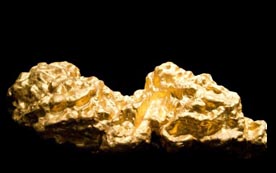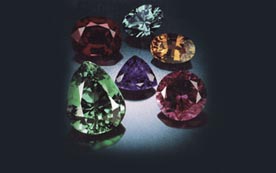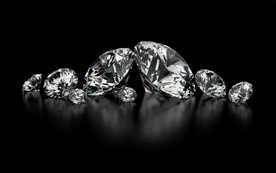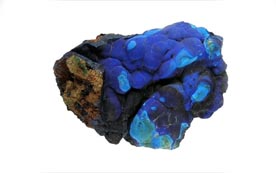Metals
12 Dec 2012- Details
- Written by Saonl
 The colour of gold depends upon the amount and type of impurities it contains. Native gold is typically golden yellow, but in order to vary its colour and increase its hardness for use in jewellery, gold may be alloyed to other metals. Silver, platinum, nickel, or zinc may be added to give a pale or white gold. Copper is added for red or pink gold; iron for a tinge of blue.
The colour of gold depends upon the amount and type of impurities it contains. Native gold is typically golden yellow, but in order to vary its colour and increase its hardness for use in jewellery, gold may be alloyed to other metals. Silver, platinum, nickel, or zinc may be added to give a pale or white gold. Copper is added for red or pink gold; iron for a tinge of blue.
Gold purity is defined by the proportion of pure gold metal present, and this is expressed as its carat (ct) value. The purity of gold used in jewellery varies from 9 carat (37/4 per cent or more pure gold), through 14, 18, and 22 carat, co 24 carat, which is pure gold. In many countries, gold is "hallmarked" to indicate its degree of purity.
- OCCURRENCE Gold is found in igneous rocks and in associated quartz veins, often in small quantities invisible to the naked eye. It is also concentrated in secondary "placer" deposits - as nuggets or grains in river sands and gravels. Gold may still be extracted from placer deposits by the traditional panning method, but modern commercial mining involves large earth-moving machinery and concentrated acids for processing the ore. The main gold-bearing rocks occur in Africa, California and Alaska (USA), Canada, the former USSR, South America, and Australia.
- REMARK Gold has been used for coins, decoration, and jewellery for thousands of years. It is attractive, easily worked, and wears well.typically rounded and flattened grains
 Platinum has been used for thousands of years, but it was not recognized as a chemical element until 1735. Of the three precious metals - gold, silver, and platinum - it is the rarest and the most valuable. Chemically inert and resistant to corrosion, placinum does not tarnish when exposed to the atmosphere, unlike silver.
Platinum has been used for thousands of years, but it was not recognized as a chemical element until 1735. Of the three precious metals - gold, silver, and platinum - it is the rarest and the most valuable. Chemically inert and resistant to corrosion, placinum does not tarnish when exposed to the atmosphere, unlike silver.
It is silvery grey, grey-white, or white in colour, opaque, and has a metallic lustre. It is slightly more dense than pure gold and about twice as dense as silver. Early jewellers had difficulty achieving the 1,773°C (3,223°F) needed to melt platinum: it was not until the 1920s that the technology was developed sufficiently to work this precious metal.
- OCCURRENCE Platinum forms in igneous rocks, usually as ores in which the grains of platinum are often too minute to be seen with the naked eye. It may also occur in secondary "placer" deposits in river sands and gravels, and glacial deposits - usually as grains, more rarely as nuggets. The main occurrences of platinum have been in South Africa, Canada (Sudbury), the USA (Alaska), Russia (the River Perm and other rivers running down from the Urals), Australia, Colombia, and Peru.
- REMARK Although nuggets had been set in rings before 1920, most platinum jewellery dates from after this time. Soft and easy to work, platinum is often fashioned into quite intricate designs.
 Silver usually occurs in massive form as nuggets or grains, although it may also be found in wiry, dendritic (tree-like) aggregates. When newly mined or recently polished, it has a characteristic-bright, silver-white colour and metallic lustre. However, on exposure to oxygen in the air a black layer of silver oxide readily forms, tarnishing the surface. Because of this, and the fact that it is too soft to be used in most jewellery in its pure form,
Silver usually occurs in massive form as nuggets or grains, although it may also be found in wiry, dendritic (tree-like) aggregates. When newly mined or recently polished, it has a characteristic-bright, silver-white colour and metallic lustre. However, on exposure to oxygen in the air a black layer of silver oxide readily forms, tarnishing the surface. Because of this, and the fact that it is too soft to be used in most jewellery in its pure form,
silver is often alloyed with other metals, or given a covering layer of gold. Electrum, an alloy of gold and silver in use since the time of the Ancient Greeks contains 20-25 per cent silver. Sterling silver contains 92'/? per cent or more pure silver (and usually some copper), and Britannia silver has a silver content of 95 per cent or more. Both alloys arc used as standards to define silver content.
- OCCURRENCE Most silver is a by¬product of lead mining, and is often associated with copper. The main silver mining areas of the world arc South America, the USA, Australia, and the former USSR. The greatest single producer of silver is probably Mexico, where silver has been mined from about AD1500 to the present day. The finest native silver, which occurs naturally in the shape of twisted wire, is from Kongsberg, Norway.

 beat
beat

 The choice of the wedding ring that will accompany the finger of the right hand forever is a very important case. What is the symbolization of a Wedding ring?? When the wedding ring established as accustom and by whom? First of all we must clearify that an Engagement ring and a Wedding ring is not the same. The engagement ring borned after 13th century when Pope Innokentios. The P declared that it should be a period between the engagement and the marriage.
The choice of the wedding ring that will accompany the finger of the right hand forever is a very important case. What is the symbolization of a Wedding ring?? When the wedding ring established as accustom and by whom? First of all we must clearify that an Engagement ring and a Wedding ring is not the same. The engagement ring borned after 13th century when Pope Innokentios. The P declared that it should be a period between the engagement and the marriage.







